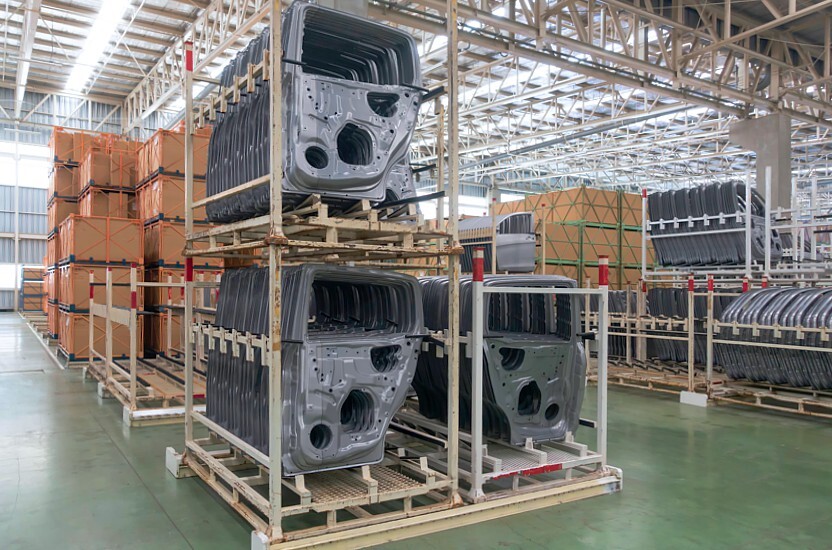When considering the packaging options for automotive parts crating, reusable crates emerge as a standout choice due to their numerous environmental benefits. These benefits are increasingly important in an industry that is looking to reduce its ecological impact. In this discussion, we’ll explore how reusable crates contribute to reduced waste generation, lower carbon footprints, resource conservation, and cost-effective sustainability.
Reduced Waste Generation
One of the most significant environmental advantages of using reusable crates for auto parts is the substantial reduction in waste generation. Traditional packaging methods often rely on single-use materials, such as cardboard boxes or plastic wrap, which are discarded after one use. This leads to a massive accumulation of waste that ends up in landfills, contributing to environmental pollution.
Reusable crates, on the other hand, are designed for durability and repeated use. Made from robust materials like high-density polyethylene (HDPE) or metal, these crates can be used hundreds or even thousands of times before needing replacement. This long lifecycle drastically cuts down on the amount of waste generated by the automotive industry. By adopting reusable crates, companies can significantly decrease the volume of discarded packaging materials, thus playing a crucial role in waste reduction efforts.
Key Points:
- Reusable crates are designed for durability and repeated use.
- Made from robust materials like high-density polyethylene (HDPE) or metal.
- Can be used hundreds or even thousands of times before needing replacement.
- Significantly decrease the volume of discarded packaging materials.
- Transitioning from waste reduction, another critical environmental benefit of reusable crates is their potential to lower the carbon footprint of shipping automotive parts.
Lower Carbon Footprint
The carbon footprint of shipping automotive parts is another critical consideration. Transportation and packaging contribute significantly to greenhouse gas emissions, primarily due to the energy consumed in the production of single-use packaging materials and the fuel used for transportation.
Reusable crates help lower the carbon footprint in several ways. Firstly, their production typically requires less energy compared to the continuous manufacturing of disposable packaging. Although the initial energy investment for producing a reusable crate may be higher, this is offset by the crate’s extended lifespan and repeated use. Secondly, the design of reusable crates often allows for more efficient stacking and loading, which optimizes space in transportation vehicles. This efficient use of space can reduce the number of trips needed to transport parts, thereby cutting down on fuel consumption and emissions.
Key Points:
- Production of reusable crates typically requires less energy compared to single-use packaging.
- Extended lifespan and repeated use offset the initial energy investment.
- Efficient stacking and loading optimize space in transportation vehicles.
- Reduced number of trips needed for transport lowers fuel consumption and emissions.
- By reducing carbon emissions through more efficient transportation and packaging processes, reusable crates also contribute to significant resource conservation.
Resource Conservation
Resource conservation is another significant environmental benefit of using reusable crates. The production of single-use packaging materials consumes vast amounts of natural resources, including trees for cardboard and petroleum for plastics. By shifting to reusable crates, the demand for these raw materials is substantially reduced.
For instance, a reusable crate made from HDPE can replace hundreds of cardboard boxes over its lifetime. This not only saves trees but also reduces the environmental impact associated with logging, paper production, and the disposal of cardboard waste. Similarly, using metal crates reduces the need for plastic production, conserving petroleum and minimizing the associated environmental damage.
Furthermore, many reusable crates are designed to be recyclable at the end of their useful life. This means that instead of ending up in a landfill, the materials can be reclaimed and used to produce new crates or other products, further conserving resources and reducing environmental impact.
Key Points:
- A reusable crate made from HDPE can replace hundreds of cardboard boxes.
- Saves trees and reduces environmental impact from logging and paper production.
- Reduces the need for plastic production, conserving petroleum.
- Many reusable crates are recyclable at the end of their useful life.
- With significant resource conservation, the next logical consideration is how reusable crates can offer a cost-effective solution for companies.
Cost-Effective Sustainability
While the environmental benefits of reusable crates are clear, it is also essential to consider their economic advantages. Companies are often hesitant to invest in sustainable practices due to perceived high costs. However, reusable crates offer a cost-effective solution that aligns with sustainability goals.
The initial investment in reusable crates may be higher compared to single-use packaging, but the long-term savings are significant. Since reusable crates are designed to last for many cycles, companies can avoid the recurring costs associated with purchasing disposable packaging materials. Over time, this leads to substantial cost savings.
Moreover, the durability of reusable crates means fewer instances of damage to auto parts during transit. Traditional packaging can often fail, leading to damaged parts and additional costs for replacements and returns. Reusable crates provide better protection, reducing the incidence of such issues and the associated costs.
Additionally, the efficiency gains in transportation, such as reduced fuel consumption and optimized shipping loads, translate into further cost savings. These economic benefits, combined with the environmental advantages, make reusable crates an attractive option for companies looking to implement sustainable practices without compromising their bottom line.
Key Points:
- Long-term savings outweigh the initial investment in reusable crates.
- Avoid recurring costs associated with disposable packaging materials.
- Better protection for auto parts during transit reduces damage and related costs.
- Efficiency gains in transportation lead to further cost savings.
Driving Forward with Reusable Crates
The shift towards using reusable crates for automotive parts crating is not just a trend but a necessary step towards a more sustainable and environmentally responsible industry. By reducing waste generation, lowering carbon footprints, conserving resources, and offering cost-effective sustainability, reusable crates present a compelling case for widespread adoption.
As more companies recognize the dual benefits of economic savings and environmental stewardship, the transition to reusable packaging solutions is likely to accelerate. This shift will not only help companies meet their sustainability goals but also contribute to a healthier planet for future generations. Embracing reusable crates is a practical and impactful way for the automotive industry to drive forward on the path of sustainable progress.
Stay in touch with us for more updates and alerts! Gossips.blog




